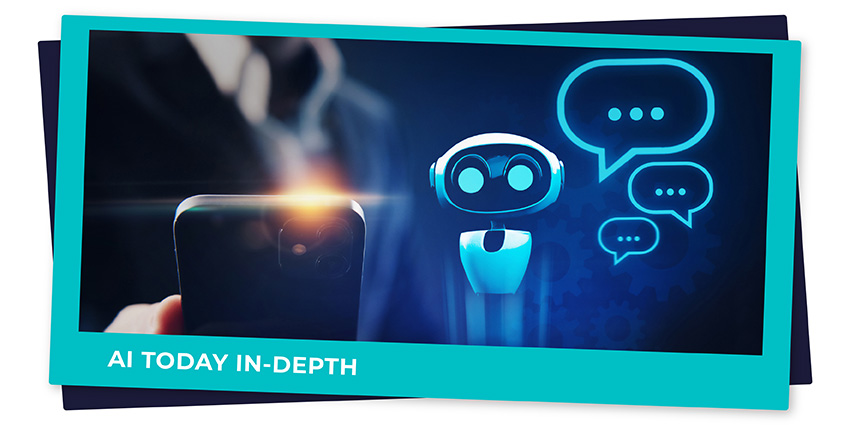What is an AI chatbot, how does it differ from a regular chatbot, and how does it work?
Chatbots are among the most popular computer programs used by businesses worldwide. These solutions can simulate human conversations with an end user, making them ideal for customer service, sales processes, and employee guidance.
Up to 80% of companies worldwide use some form of chatbot, but not all of these bots are powered by artificial intelligence. Traditional chatbots were simple rule-based solutions capable of delivering specific responses to certain prompts—a lot like an automated FAQ system.
AI chatbots, on the other hand, leverage conversational and generative AI techniques, machine learning, and advanced algorithms to enhance human interactions. Here’s your guide to AI chatbots, how they work, and how the technology is advancing.
What is an AI Chatbot?
An AI chatbot is a software solution or program that uses artificial intelligence algorithms to simulate natural, human interactions. Unlike traditional rules-based chatbots, AI algorithms leverage techniques like natural language processing, language generation, and machine learning to process interactions, complete tasks, and automate everyday operations.
Where traditional chatbots were programmed with specific responses to certain queries, AI chatbots can detect the intent of a query and deliver more creative, accurate responses. With the help of machine learning, these systems can mimic human traits like problem-solving, creative thinking, and reasoning, enabling enhanced human/machine interactions.
How Do AI Chatbots Work?
The main difference between traditional and AI chatbots is how they process data and respond to queries. The earliest chatbots acted a lot like interactive FAQ programs. They were programmed to respond to specific prompts with pre-written answers.
These systems couldn’t process natural language, so they generally just allowed users to select from simple keywords and phrases to move a conversation forward. Over time, introducing AI algorithms into chatbots transformed how these systems could operate.
Natural language processing emerged to give bots “conversational” abilities, allowing them to understand human input and respond more naturally. Machine learning allowed these bots to become contextually aware and continuously optimize their performance as they were exposed to larger volumes of data and more human language.
Modern AI chatbots even use natural language understanding (NLU), to understand the meaning behind open-ended human input. This means they can sidestep everything from typos to translation issues when interacting with human beings. These tools can then map the specific intent of each user before formulating the right response.
Different types of AI chatbots leverage different algorithms and technologies. Most rely on machine learning and deep learning. However, some also draw on advancements in large language modeling and generative AI to enable deeper, more creative interactions.
Chatbots vs. AI Chatbots vs. Virtual Assistant
Many people struggle with the question: “What is an AI chatbot?” because this technology is often confused with other “bot” systems, like traditional chatbots and virtual assistants. However, there are some significant differences between these tools.
Chatbot is the all-inclusive, catch-all term used to refer to any kind of software capable of mimicking human conversation. Chatbots can be powered by rigid menus or cutting-edge conversational AI. Bots that leverage artificial intelligence, from NLP to machine learning and LLMs, are known as AI chatbots.
These bots employ various AI technologies to more accurately interpret user input and match it to specific intents or requirements. They can also become more advanced over time, using machine learning and deep learning to improve their responses almost autonomously.
Virtual agents, on the other hand, are an evolution of AI chatbot software that uses additional forms of technology. Like AI chatbots, they rely on conversational AI and deep learning. However, they’re often paired with robotic process automation, which allows them to complete a wider range of tasks.
To understand the difference, imagine that you want to learn more about tomorrow’s weather forecast. A traditional chatbot could respond to a question like “Tell me tomorrow’s weather forecast” with pre-programmed information about the forecast.
An AI chatbot could answer any question about the weather, like “What does the weather look like tomorrow?” by examining the intent of that question and sourcing the correct data. On the other hand, a virtual agent could predict the weather and allow users to complete tasks. For instance, it could allow users to set an alarm to get up earlier and avoid a storm on the way to work.
What is an AI Chatbot Used for? Common Use Cases
Businesses and consumers already use AI chatbots for a range of tasks. The market for AI chatbots is set to be worth $66.6 billion by 2033. The use cases for AI chatbots vary based on the type of AI algorithms and features they include.
Consumers can use AI chatbots built into mobile devices and IoT devices like smart thermostats to gather data and complete tasks. Marketers can use AI-powered chatbots to streamline ecommerce operations, answer common questions, and personalize customer experiences.
IT and HR teams can use these tools to enable employee self-service, allowing teams to troubleshoot problems and resolve issues without human intervention. Plus, contact centers use AI chatbots to deliver convenient self-service to customers.
Advanced AI chatbots, with conversational AI and RPA capabilities, can take these tools’ use cases to the next level. For instance, they can empower users to complete tasks with the help of a bot instead of a human agent, such as processing a transaction. Overall, some of the most significant use cases for AI chatbots include:
- Delivering always-on, personalized customer support to consumers.
- Providing guidance and real-time assistance to agents and employees.
- Promoting products and services via proactive marketing strategies.
- Managing tasks like appointment scheduling and reminders.
- Streamlining the use and management of IoT (Internet of Things) devices.
AI Chatbots and Generative AI
AI chatbots come in various forms and serve many different use cases. Conversational chatbots are some of the most common AI chatbots used today. These leverage machine learning, natural language processing, and deep learning to engage in realistic conversations with human beings.
Generative AI builds on the capabilities of conversational AI chatbots with new features and functionality. Gen AI chatbots represent the next era of chatbot technology. Gen AI allows systems to understand human language and complex queries and respond more effectively to users.
With generative AI and large language models, chatbots can understand more forms of language and input, adapt to a user’s conversation style, and even mimic empathy and creativity. Already, companies worldwide are seeing the benefits of bringing generative AI into chatbots.
With conversational and generative AI, companies will no longer need to create FAQ chatbots with pre-programmed answers. Instead, they can create bots leveraging data from a knowledge base and its training to address a wider range of queries.
Additionally, while conversational AI chatbots can understand a customer’s questions and generate a response, gen AI bots will take this further. Instead of just surfacing answers from a database, they can create new, novel content as an output to a query. This output can include text, sound, and images based on the LLMs the bot has been trained to use.
Plus, chatbot solutions featuring generative AI capabilities can recognize, predict, translate, and create content without human interaction.
The Benefits of AI Chatbots
An AI chatbot has the ability to accurately process human language and streamline tasks in the business landscape, introducing a range of benefits to organizations and consumers. Some of the biggest benefits of AI chatbot technology include:
Improved Customer Engagement and Service
Before chatbots emerged in the business landscape, every consumer query, from minor questions about delivery times to complaints, needed to be handled by a human being. Since customers can require assistance at any time of the day or night, ensuring teams were always available to respond to queries was extremely difficult.
Chatbots now allow companies to manage customer interactions 24/7 without significant operational costs. An AI chatbot also ensures companies can deliver a better quality of service to customers. AI systems can personalize interactions with customers based on the data they have access to and help them complete a range of tasks.
Reduced Costs and Greater Operational Efficiency
Chatbots are excellent at automating tasks that would otherwise be time-consuming and expensive for businesses. They can handle 24/7 customer service and provide real-time guidance to employees. They can also help with troubleshooting problems and streamline onboarding.
AI chatbots can give any user in a business environment access to an always-on assistant who can deliver information and respond to questions 24/7. They can reduce the number of users who require human assistance, helping businesses operate more efficiently and minimize costs.
Increased Revenue and Profitability
AI chatbots, with their ability to support both employees and customers, can help boost revenue in various ways. They can make teams more efficient and productive, increasing performance metrics that eventually impact business profits. They can gather data that helps companies make intelligent growth decisions and even proactively generate leads for businesses.
AI bots can proactively connect with customers browsing a website or using a mobile app, answering questions they might have, highlighting the features of different products, and even making personalized product suggestions. This leads to increased customer satisfaction and opportunities for more revenue and conversions in any business environment.
The Limitations of an AI Chatbot
Clearly, AI chatbots are far more versatile and potentially advantageous than traditional chatbots. However, they still have their limitations. Traditional chatbots could not respond to a wider range of queries and complete certain tasks. But, they did give companies more control.
On the other hand, new AI chatbots present new security and compliance risks. They rely on huge amounts of data; training these systems can lead to ethical concerns. For instance, bots trained with sensitive customer information could leak that data to external parties.
Plus, there’s a risk that chatbots may be trained with incomplete data. This leads to a higher risk of bias in responses and AI hallucinations. Generative AI chatbots, in particular, can deliver inaccurate and irrelevant answers to users based on limited databases.
Furthermore, the rise of more advanced AI chatbots has led to greater concerns about human beings becoming obsolete in certain roles, like customer service.
Tips for AI Chatbot Implementation
The key to unlocking the full benefits of an AI chatbot while keeping risks to a minimum is developing the right implementation strategy. Companies need to take the time to assess their use cases for chatbot technology and select the right platform for success.
Different use cases call for different types of AI technology. For instance, a company that wants to automate employee support would need a bot with conversational and generative AI capabilities and robotic process automation functionality.
Here are some quick tips for effective AI chatbot implementation:
- Think long-term: Ideally, the right chatbot solution should address your organization’s most significant issues and challenges but also give you the room you need to scale. Consider whether your solution will enable you to unlock new functionality as your needs evolve.
- Embrace connectivity: An AI chatbot shouldn’t replace the tools your company already uses, from CRM systems to troubleshooting technologies and contact center applications. Instead, it should connect with these tools, augmenting their performance and introducing new opportunities for enhanced user experiences.
- Invest in training: The best AI chatbots may feature machine learning algorithms, which allow them to improve automatically over time. However, training, refining, and fine-tuning these bots with human input will still be necessary. The ability to optimize bots over time will help to reduce the risk of bias, hallucinations, and security issues.
The Future of AI Chatbot Technology
Ultimately, AI chatbot technology benefits today’s consumers and businesses alike. It ensures companies can go beyond simple, rule-based solutions to support employees and deliver exceptional customer service.
Chatbot technology will only become more advanced as technology evolves. Developers constantly discover ways to make bots more accurate, human, and powerful. Advances in conversational and generative AI have already introduced more human-like bots.
As researchers continue to find new ways to enhance bots’ intelligence, we’ll see a future where bots are more intuitive, empathetic, and effective in the digital world.








